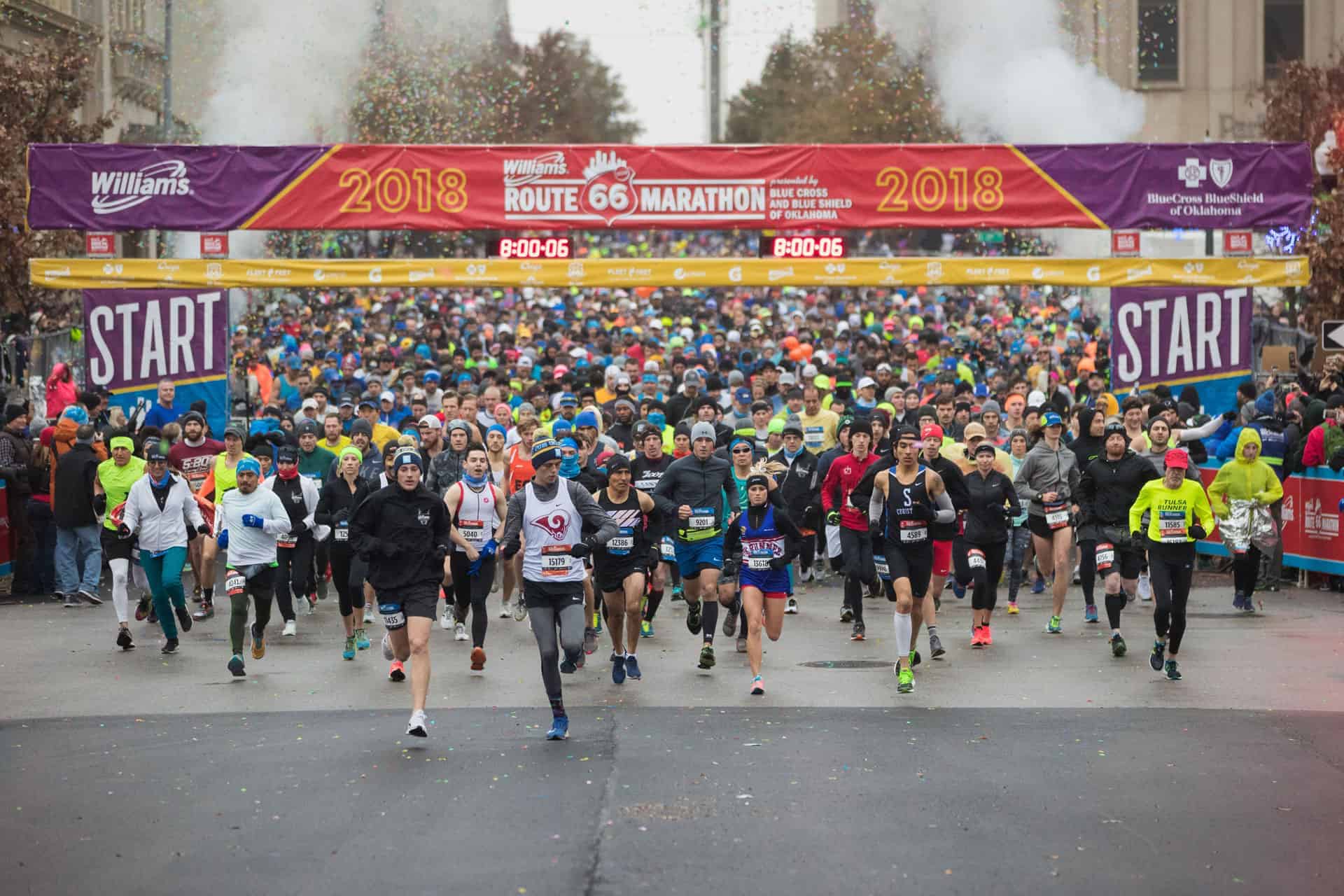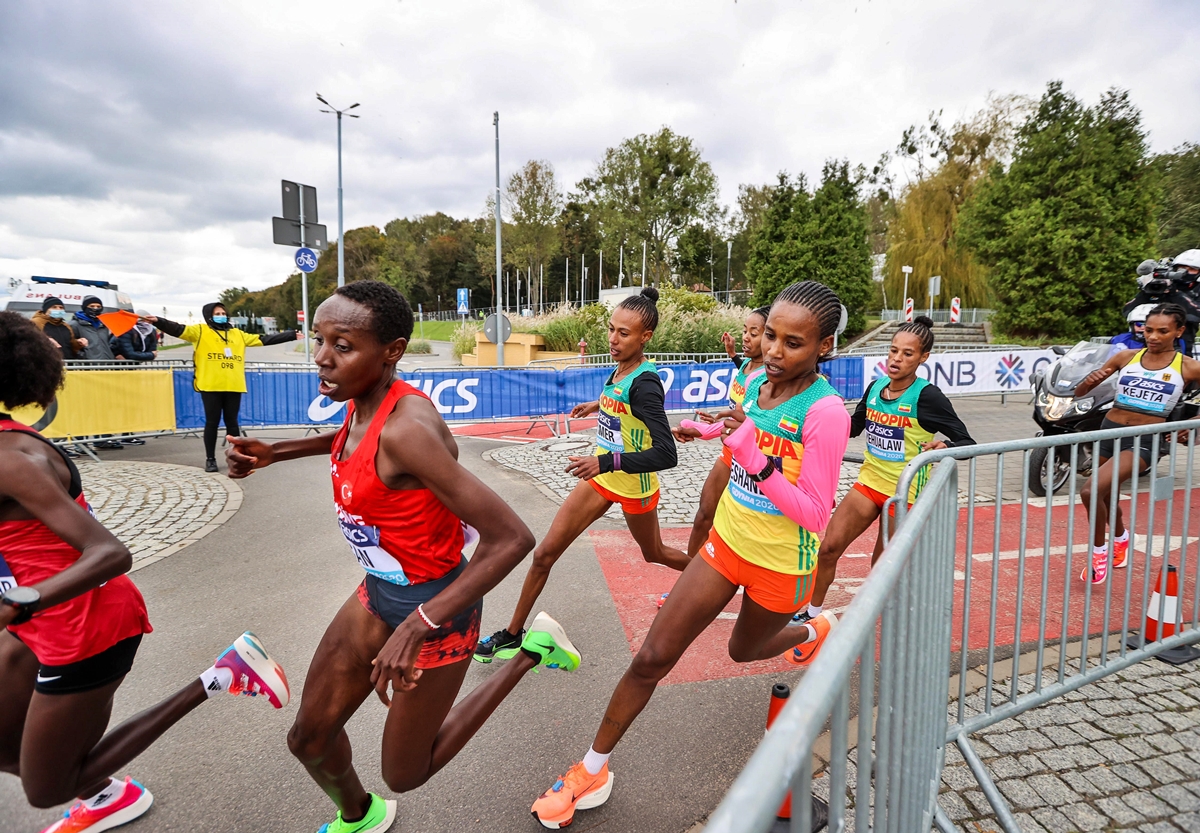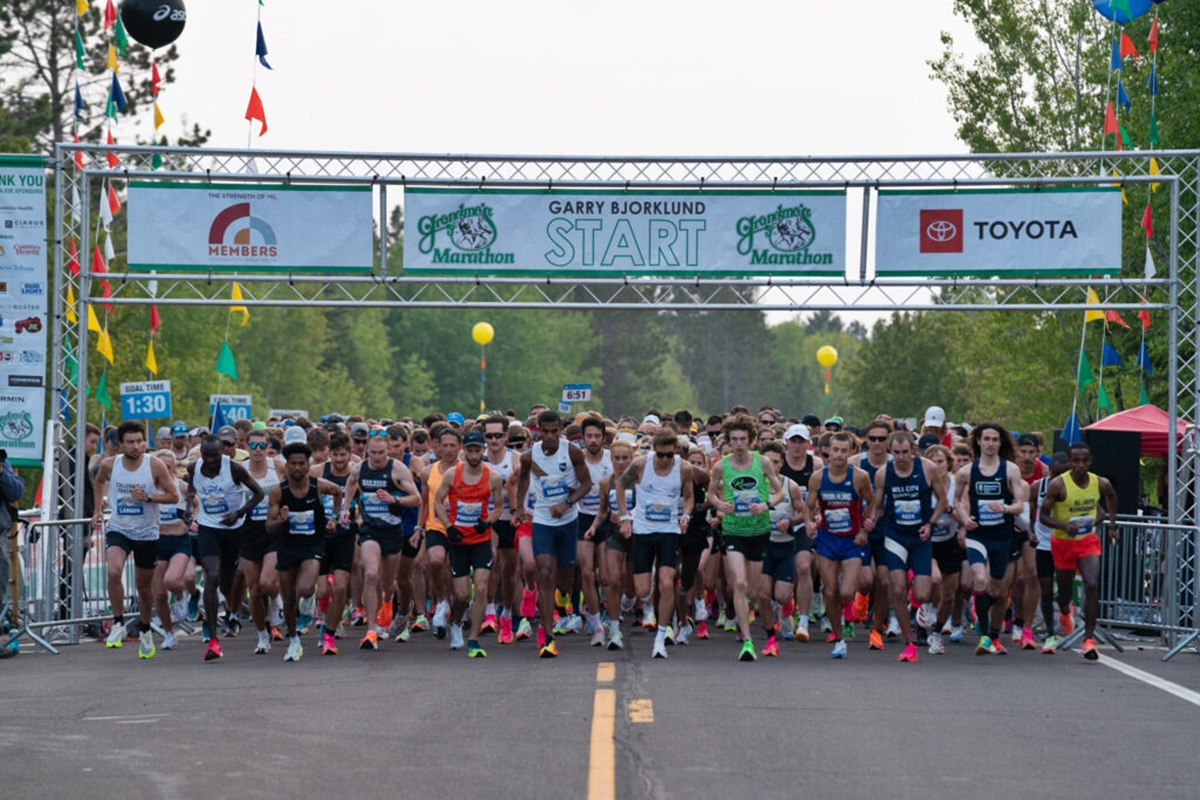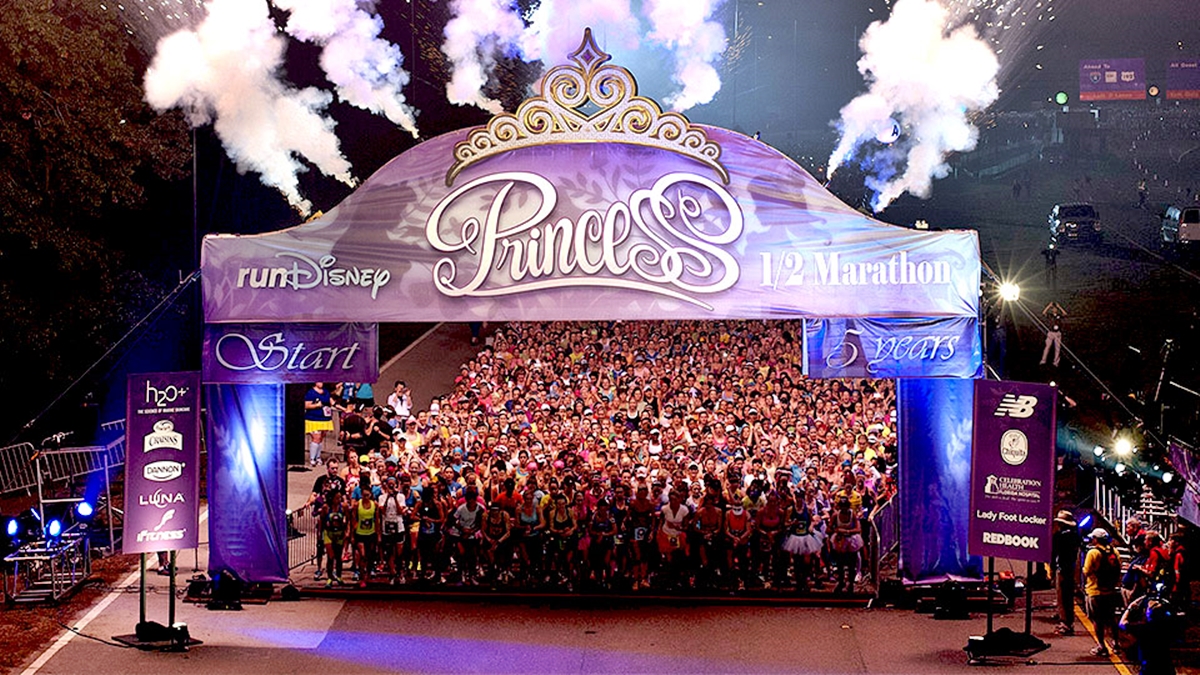

Featured
What Is A Half Marathon
Modified: January 22, 2024
Discover everything you need to know about half marathons, from training tips to race strategies. Stay featured and reach your running goals with our expert guidance.
Introduction
Welcome to the fascinating world of half marathons! Running a half marathon is an exhilarating experience that combines the thrill of endurance, the joy of accomplishing a fitness goal, and the camaraderie of being part of a vibrant running community. Whether you are a seasoned runner or a newbie looking for a new challenge, participating in a half marathon can be an incredibly rewarding adventure.
A half marathon is a long-distance running race that covers 13.1 miles or 21.0975 kilometers. It is a popular race distance for both recreational and competitive runners, offering a significant challenge without the full commitment of training for a marathon. Half marathons attract a wide range of participants, from elite athletes pushing for a personal best to amateurs looking for a fun and fulfilling fitness goal.
The history of half marathons dates back to the early 20th century when road races became increasingly popular. The first official half marathon race, the Plymouth to Plymouth, was organized in England in 1908. Over time, the popularity of half marathons grew, and they became a staple in the running calendar across the globe.
Today, there is an impressive array of half marathon races held worldwide, ranging from iconic city races like the New York City Half Marathon and the Great North Run in Newcastle, England, to scenic routes like the Big Sur Half Marathon in California and the Zermatt Half Marathon in Switzerland. These races attract thousands of participants every year, showcasing the universal appeal and enduring popularity of the half marathon distance.
Preparing for a half marathon requires dedication, commitment, and a well-designed training plan. It is essential to gradually build your endurance, improve your speed, and prevent injuries. With the right approach and the guidance of a training program, anyone with reasonable fitness can successfully complete a half marathon.
Running a half marathon offers numerous physical and mental benefits. It not only helps improve cardiovascular fitness, strengthen muscles, and burn calories but also boosts mental resilience, self-confidence, and overall well-being. Crossing the finish line after completing a half marathon is an incredible accomplishment that leaves participants with lasting memories and a sense of pride.
In this article, we will explore all aspects of half marathons, including training tips, the differences between half and full marathons, and the joy of participating in these iconic races. So, lace up your running shoes and get ready to dive into the thrilling world of half marathons!
Definition of a Half Marathon
A half marathon is a long-distance running race that covers a distance of 13.1 miles or 21.0975 kilometers. It is half the distance of a full marathon, hence the name “half marathon.” This race distance has gained significant popularity in recent years, attracting both seasoned runners and beginners looking to challenge themselves.
Half marathons are organized as standalone events or as part of larger running festivals. They typically take participants through a variety of terrains, including roads, trails, and scenic routes, providing an opportunity to explore different landscapes and environments. The race is typically marked by mile markers, aid stations, and cheering crowds, creating an exciting and memorable experience for runners.
Unlike shorter distance races, such as 5K or 10K races, half marathons require a greater level of physical fitness and endurance. Training for a half marathon involves a combination of long runs, speed work, strength training, and cross-training exercises to prepare the body for the sustained effort required to complete the race. It is recommended that participants have a base level of fitness before embarking on half marathon training.
Half marathons offer a unique challenge for runners. They require not only physical stamina but also mental strength and determination to push through fatigue, doubts, and discomfort. The race distance allows runners to test their limits and set new personal goals, making it a popular choice for those seeking a longer and more demanding running experience.
One of the distinctive features of a half marathon is the sense of accomplishment and satisfaction that comes with crossing the finish line. Completing 13.1 miles is a significant achievement and brings a tremendous sense of pride and fulfillment. Participants often celebrate their accomplishment and treasure the memories of overcoming the challenges and pushing beyond their perceived limits.
Half marathons are also known for their inclusive and supportive atmosphere. Participants come from all walks of life, each with their own story and motivation for running the race. The running community is welcoming and encouraging, and the race environment fosters a sense of camaraderie and mutual support.
Whether your goal is to set a personal record, raise money for charity, or simply challenge yourself to reach new heights, a half marathon offers a fulfilling and rewarding experience. It is a test of strength, resilience, and determination, pushing you to discover what you are truly capable of achieving.
History of Half Marathons
The roots of half marathons can be traced back to the early 20th century when road races started gaining popularity. The first official half marathon race took place in England in 1908, called the Plymouth to Plymouth race. It covered a distance of 13.1 miles and was organized as a training event leading up to the full marathon at the 1908 London Olympics.
Half marathons didn’t gain widespread recognition until the 1960s and 1970s, when long-distance running surged in popularity. The growing interest in road races and the desire to challenge oneself beyond the standard 10K distance led to the establishment of half marathons as stand-alone events.
In 1970, the Gothenburg Half Marathon in Sweden became the first officially recognized half marathon race. Since then, the popularity of half marathons has skyrocketed, with races organized in cities and towns around the world.
In the United States, the New York City Half Marathon, established in 2006, has become one of the most prestigious and popular half marathons. It offers a scenic course through the city’s streets, attracting thousands of participants each year.
The Great North Run, held annually in Newcastle, England, is another iconic half marathon. It was first organized in 1981 and has grown into one of the largest half marathons globally, drawing in professional athletes and recreational runners alike.
Half marathons have also gained popularity in marathon majors events. The Boston Marathon, one of the most renowned marathons in the world, introduced a half marathon component in 2001. The Boston Half Marathon allows runners, who may not qualify for the full marathon, to experience the excitement of running a portion of the iconic course.
Half marathons have evolved beyond traditional road races. Trail half marathons, where runners tackle off-road terrain and rugged landscapes, have gained a dedicated following. These races provide a unique and challenging experience for trail running enthusiasts.
The growth of half marathons can be attributed to several factors. The distance offers a significant challenge for runners, making it appealing to those looking for a stepping stone between a 10K and a full marathon. The growing interest in fitness and wellness, along with the rise of running as a community-oriented sport, has also contributed to the surge in half marathon participation.
Today, half marathons continue to attract a diverse range of runners, from seasoned athletes aiming for personal records to recreational runners seeking a new fitness goal. They have become an integral part of the global running calendar, showcasing the universal appeal of long-distance running and the remarkable achievements that can be accomplished through dedication and perseverance.
Popular Half Marathon Races
Half marathons have gained immense popularity worldwide, with numerous races being held in cities, towns, and scenic locations. These races offer participants the opportunity to challenge themselves, explore new destinations, and be part of vibrant running communities. Here are some of the most popular half marathons around the globe:
- New York City Half Marathon: Held annually in the Big Apple, this race takes participants through the bustling streets of New York City. With iconic landmarks along the course, including Central Park and Times Square, it offers a truly unique and exciting running experience.
- Great North Run: Organized in Newcastle, England, this half marathon attracts thousands of participants every year. Known for its friendly atmosphere and enthusiastic crowd support, it provides runners with a scenic route that crosses the iconic Tyne Bridge and finishes along the coastline.
- Big Sur Half Marathon: Located on the stunning California coastline, this race offers breathtaking views of the Pacific Ocean and picturesque landscapes. Runners are treated to a challenging yet rewarding course, incorporating rolling hills and the famous Bixby Bridge.
- Zermatt Half Marathon: Set against the backdrop of the Swiss Alps, this race takes participants through the charming mountain village of Zermatt. With stunning views of the Matterhorn and a challenging course, it offers a truly memorable experience in one of the world’s most beautiful locations.
- Berlin Half Marathon: As part of the Berlin Marathon weekend, this race allows participants to soak in the vibrant atmosphere of the German capital. With a fast and flat course, it attracts elite runners aiming for personal records, as well as recreational runners seeking a memorable race experience.
These are just a few examples of the many incredible half marathons held worldwide. Other notable races include the Disneyland Half Marathon in Anaheim, California, the Bath Half Marathon in the United Kingdom, the Lisbon Half Marathon in Portugal, and the Tokyo Marathon in Japan.
Participating in a popular half marathon offers more than just a race. It provides an opportunity to immerse oneself in the local culture, meet fellow runners from different backgrounds, and create lasting memories. The festive atmosphere, cheering crowds, and well-organized support systems make these races an exciting and enjoyable experience for participants of all levels.
Whether you are looking for a world-famous race or a hidden gem off the beaten path, the variety of half marathons available ensures that you can find the perfect event to suit your preferences and goals. Whether it’s taking in the bright lights of a big city or reveling in the serenity of nature, participating in a half marathon allows you to combine your passion for running with unforgettable experiences in incredible locations.
Training for a Half Marathon
Training for a half marathon is a key component of successfully completing the race and enjoying the journey along the way. A well-designed training plan will help you build the necessary endurance, improve your running efficiency, and prevent injuries. Here are some important factors to consider when preparing for a half marathon:
1. Establish a training schedule: It is crucial to have a structured training plan that includes a combination of running, cross-training, and rest days. The plan should gradually increase the distance and intensity of your runs over a period of several weeks to allow your body to adapt and improve.
2. Build a strong foundation: Before starting your half marathon training, it is recommended to have a base level of fitness. Regular running and other forms of cardiovascular exercise will help prepare your body for the demands of longer distance running.
3. Long runs: Long runs are a key element of half marathon training as they help build endurance and mental resilience. Each week, gradually increase the duration of your long run, aiming to cover the desired race distance or slightly beyond.
4. Speed and tempo workouts: Incorporate speed work and tempo runs into your training plan to improve your pace and running efficiency. Interval training, fartleks, and tempo runs can help increase your speed and make you more comfortable with faster race paces.
5. Strength and cross-training: Include strength training exercises to build core stability, strengthen leg muscles, and prevent injuries. Cross-training activities like swimming, cycling, or yoga can also provide a break from running while still improving overall fitness.
6. Rest and recovery: Rest days are just as important as training days. Your body needs time to repair and strengthen itself, so make sure to incorporate rest days into your training plan. Proper hydration, nutrition, and quality sleep are also essential for optimal recovery.
7. Listen to your body: Pay attention to any signs of fatigue, pain, or overtraining. It’s important to be flexible with your training plan and make adjustments when needed. If you’re feeling excessively tired or experiencing persistent pain, consult with a healthcare professional.
8. Practice race-day conditions: As your training progresses, incorporate elements that mimic race-day conditions. Run in similar weather conditions, practice fueling strategies, and wear the gear you plan to use on race day. This will help you familiarize yourself with potential challenges and ensure a smooth race experience.
Remember, everyone’s training needs and capabilities are unique. It’s vital to listen to your body, stay consistent with your training, and gradually progress to avoid injury or burnout. With dedication, perseverance, and a well-rounded training plan, you’ll be well-prepared to conquer the challenges and enjoy the exhilaration of completing a half marathon.
Benefits of Running a Half Marathon
Running a half marathon offers numerous physical, mental, and emotional benefits. It is not only a test of endurance but also an opportunity for personal growth and self-discovery. Here are some of the key benefits of running a half marathon:
- Improved cardiovascular fitness: Training for a half marathon requires consistent running, which leads to improvements in cardiovascular health. Running strengthens the heart, increases lung capacity, and enhances overall circulation, resulting in a healthier cardiovascular system.
- Weight management: Running a half marathon can be an effective way to manage weight. The high-intensity nature of running helps burn calories and increase metabolism, leading to potential weight loss and weight maintenance.
- Mental resilience: Completing a half marathon requires mental strength and resilience. Enduring the physical challenges of long-distance running and overcoming mental barriers during the race can boost your confidence, determination, and mental toughness, which can be applied to other areas of life.
- Stress relief: Running has been shown to reduce stress levels and improve mood. The release of endorphins, also known as “feel-good” hormones, during exercise can help alleviate stress, anxiety, and symptoms of depression.
- Sense of accomplishment: Crossing the finish line after completing a half marathon is an incredible achievement. The sense of accomplishment and pride that comes with finishing a challenging race can boost self-esteem and provide a lasting sense of fulfillment.
- Community and camaraderie: Half marathons bring together a diverse group of individuals with a shared passion for running. Participating in the race exposes you to a supportive community, fosters new friendships, and allows you to connect with like-minded individuals who share similar goals and experiences.
- Opportunity for goal setting: Training for a half marathon provides an opportunity to set and achieve personal goals. Whether it’s completing your first half marathon, setting a new personal record, or conquering a challenging course, the process of goal setting and working towards it can enhance motivation and self-discipline.
- Improved overall fitness: Half marathon training involves a well-rounded approach to fitness. In addition to running, it often includes strength training, cross-training, and flexibility exercises. This comprehensive training approach improves overall fitness, strength, and flexibility, leading to a well-rounded and balanced physique.
- Sense of adventure: Running a half marathon gives you the opportunity to explore new routes and environments. Whether it’s running through city streets, along picturesque trails, or in scenic destinations, the race experience brings a sense of adventure and exploration to your running journey.
While the physical and mental benefits of running a half marathon are significant, it’s important to remember that each individual’s experience may vary. It’s essential to consult with a healthcare professional before embarking on a half marathon training journey, especially if you have any underlying health concerns or medical conditions.
Running a half marathon is not only about the race day itself but also about the personal growth, self-discovery, and enjoyment of the journey leading up to it. The process of training, setting and achieving goals, and embracing the running community can have a transformative impact on your overall well-being and leave you with lifelong memories and a sense of accomplishment.
Tips for Running a Successful Half Marathon
Preparing for and running a half marathon requires careful planning and execution. Here are some essential tips to help you have a successful and enjoyable race:
- Follow a training plan: Stick to a well-rounded training plan that includes a mix of distance runs, speed workouts, strength training, and rest days. Gradually increase your mileage and intensity to build endurance and minimize the risk of injury.
- Set realistic goals: Establish achievable goals based on your fitness level, training progress, and previous race experience. Setting realistic expectations will help you stay motivated and avoid unnecessary pressure or disappointment.
- Stay consistent: Consistency is the key to success in half marathon training. Stay committed to your training schedule and make running a regular part of your routine. Consistency will help you build endurance and improve your running performance.
- Practice race-day conditions: Familiarize yourself with race-day conditions by running in similar weather, terrain, and time of day. Practice your hydration and fueling strategies during training runs to ensure they work well for you on race day.
- Focus on nutrition: Fuel your body with a well-balanced diet that includes plenty of carbohydrates, lean proteins, and healthy fats. Avoid trying new foods or drinks on race day and instead stick to what has worked well for you during training.
- Hydrate effectively: Proper hydration is crucial during half marathon training and on race day. Stay hydrated by drinking water regularly throughout the day and during your long runs. Consider carrying a water bottle or using aid stations strategically during the race.
- Listen to your body: Pay attention to any signs of fatigue, discomfort, or injury during training. Pushing through minor pain can lead to more severe injuries. If you feel extreme pain or prolonged discomfort, seek professional medical advice.
- Get adequate rest: Rest and recovery are crucial for performance and injury prevention. Incorporate rest days into your training schedule, prioritize getting enough quality sleep, and allow your body time to recover between workouts.
- Stay motivated: Keep your motivation high by setting milestones, visualizing success, and finding running buddies or a supportive community. Use positive self-talk and remind yourself of the reasons you chose to run a half marathon.
- Enjoy the experience: Embrace the journey and enjoy the process of training and running a half marathon. Take time to appreciate the sights, sounds, and camaraderie on race day. Celebrate your achievement and be proud of yourself for completing this challenging race.
Remember, each runner’s experience is unique, so it’s important to find what works best for you. Experiment with different training techniques, nutrition strategies, and mental preparation to discover what helps you perform at your best. With proper training, preparation, and a positive mindset, you will be well-equipped to conquer your half marathon and create lasting memories along the way.
Half Marathon vs. Full Marathon: Key Differences
Running a half marathon and a full marathon are both significant accomplishments in the world of distance running. While they share similarities, such as the dedication required for training and the sense of achievement upon completion, there are some key differences between the two. Here are the main distinctions:
- Distance: The most obvious difference is the distance covered. A half marathon is 13.1 miles or 21.0975 kilometers, while a full marathon is 26.2 miles or 42.195 kilometers. The additional distance in a full marathon requires greater endurance and stamina.
- Time commitment: Training for a full marathon typically requires a more significant time commitment compared to a half marathon. The longer distance necessitates more training runs, longer training sessions, and potentially higher weekly mileage.
- Physical demands: Running a full marathon puts more strain on the body due to the extended duration of the race. It requires a higher level of physical fitness, strength, and durability. The intensity and duration of training for a full marathon can lead to a higher risk of overuse injuries compared to training for a half marathon.
- Mental challenges: The mental challenges in a full marathon are often more pronounced. The extended duration of the race requires mental resilience, determination, and the ability to push through physical and mental fatigue. The psychological aspect of a full marathon can be both rewarding and demanding.
- Recovery time: Following a full marathon, the body typically requires a longer recovery period compared to a half marathon. The physical toll on the body is greater, and adequate rest and recovery are crucial for allowing muscles to repair and replenish glycogen stores.
- Pacing and strategy: Pacing and race strategy may differ between a half marathon and a full marathon. In a half marathon, runners may focus on maintaining a faster pace throughout the race, whereas in a full marathon, a more conservative pace may be utilized to ensure energy is conserved for the latter stages.
- Sense of accomplishment: Completing a half marathon is a significant achievement in itself, but finishing a full marathon carries an extra sense of accomplishment due to the distance and physical and mental challenges overcome. The satisfaction of conquering the full 26.2 miles is often greater for marathon finishers.
Deciding whether to run a half marathon or a full marathon depends on various factors, including your fitness level, running experience, time commitment, and personal goals. It is important to assess your physical fitness, consider the time and effort you can allocate to training, and set realistic goals that align with your capabilities and aspirations.
Ultimately, both half marathons and full marathons provide opportunities for personal growth, self-discovery, and a sense of accomplishment. Whether you choose to conquer the half marathon distance or tackle the full marathon challenge, each race offers its own unique journey and rewards.
Conclusion
Participating in a half marathon is an extraordinary undertaking that offers a multitude of physical, mental, and emotional benefits. The half marathon distance provides an exciting challenge for runners of all levels, allowing them to push their boundaries, set new personal goals, and experience the thrill of overcoming obstacles.
From its humble beginnings in the early 20th century to the expansive global presence it holds today, the half marathon has become an iconic race distance that captivates runners around the world. Whether you choose to run through the bustling streets of major cities, along scenic routes, or on challenging trail courses, the half marathon offers a diverse range of experiences for every participant.
Training for a half marathon demands dedication, commitment, and a well-structured plan. Gradually building endurance, improving speed, and implementing strength and cross-training exercises will prepare the body for the demands of race day. By following a training plan, listening to your body, and staying consistent, you can be confident in your ability to conquer the 13.1-mile journey.
Running a half marathon boasts an array of benefits. It improves cardiovascular fitness, aids in weight management, enhances mental resilience, and fosters a sense of achievement and camaraderie within the running community. The satisfaction of crossing the finish line and reflecting on the months of preparation and hard work is an incredible feeling that resonates long after the race is over.
While a half marathon may not be as physically demanding or time-consuming as a full marathon, it still presents a significant challenge that should not be underestimated. The race allows runners to embrace their passion for running, connect with like-minded individuals, and explore new destinations and environments.
Regardless of whether you choose to embark on the half marathon journey for the first time or are a seasoned participant, remember to enjoy the experience. Embrace the training process, relish the race-day atmosphere, and celebrate your accomplishments along the way. Running a half marathon is not just an achievement, but a testament to the human spirit and the limitless possibilities that come with dedication and determination.









